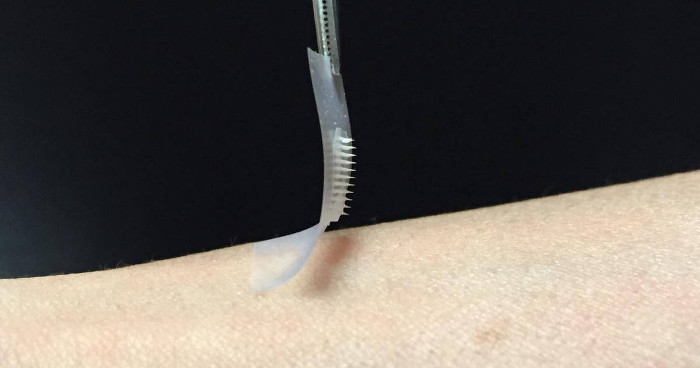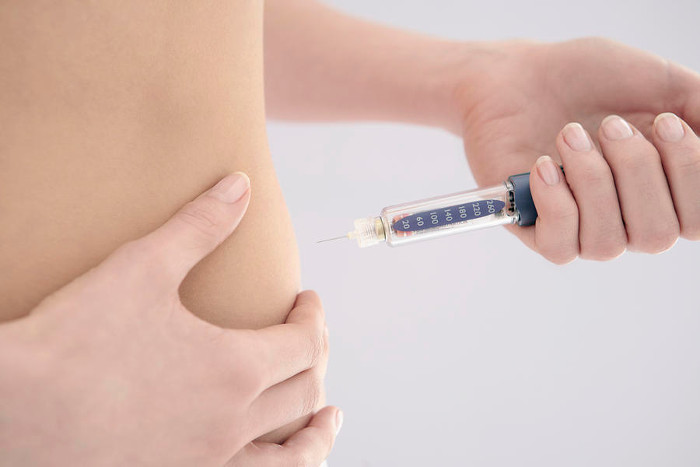Invention helps people with diabetes do not need to pay attention to regular insulin injections
For decades, scientists have been constantly working to find ways to help diabetics no longer have regular insulin injections. One of the most positive directions is healthy β cell transplantation, which produces insulin into the patient's pancreas. However, this will require an invasive surgery, which entails a greater risk of rejection by the patients themselves.
Recently, a much simpler idea has been proposed to address this bottleneck. The researchers built a patch and coated it with β cells. Diabetics simply need to apply them to the skin, without injections, without pain, to be able to control insulin and blood sugar automatically.

This simple patch can replace insulin injections for diabetics.
Although not yet tested on humans, the patches worked very well on mice. They kept blood sugar in a safe level for 10 hours. Live β cells are kept outside the body safely. Therefore, they are not eliminated by the patient's own immune system.
In fact, the patch was developed based on last year's research by a group of scientists. At that time, they created patches containing directly synthetic insulin. However, at that time, the amount of supplemental insulin was difficult to control and prolonged its use as a patch containing cells dán. This shows that this new version is a very valuable upgrade.
"Research provides a potential solution for diabetics , " said Zhen Gu in the research team from the University of North Carolina. Patients often refuse previous pancreatic cell transplantation solutions that require invasive surgery.
"In addition, the study also demonstrates that we are fully capable of building a bridge between physiological signals in the body, with external therapeutic cells. This is aimed at tight control. Blood sugar levels, " Zhen Gu added.

Diabetic patients need regular insulin injections, especially type 1 diabetes.
Β cells are often found in the pancreas, where insulin is produced to help resolve excess blood sugar after meals. In diabetics, these cells either completely fail, or are unable to produce insulin to control blood sugar. That's why they have to inject insulin regularly.
The patch is made with a series of micrometer needles, equivalent to the diameter of the eyelash tip. While it sounds scary, researchers say they don't cause any pain when applied to the skin.
The needles pierce capillaries, allowing cells β on them to come into contact with diabetic blood. The team developed a mechanism called "signal amplification". It will measure blood sugar. If abnormal signals are identified, immediately β cells will be aware of the need to produce insulin.
In tests with mice with type 1 diabetes, the patch responded very quickly when blood sugar skyrocketed. At the same time, it also keeps the amount of sugar under control for 10 consecutive hours. This is completely natural, does not require any monitoring or adjustment.

The needle tip of the patch under the electron microscope.
Besides being quick and easy to use, patches that have been tested successfully for humans can also solve many of the dangerous problems of insulin injections. Usually, patients do not know exactly how much insulin they need to inject.
The lack of excess can lead to many complications such as hypoglycemia, blindness, coma or even death.
For patches, they do not produce extra insulin when blood sugar is controlled. This is inevitable when scientists add another piece to mice that have normal blood sugar levels. Not only did insulin not secrete, treatment was also doubled up to 20 hours.

Designing patches with β cells and glucose signal amplification mechanisms.
Now, before you are too excited, there is still a long way for these stickers to appear on the market. First of all, scientists need to refine their performance and errors when experimenting with animals. The next step is to come to a human clinical trial.
However, all current research evidence is pointing to a straight path to the day when diabetics die from insulin syringes. They will have an easier, safer, more effective and less painful treatment.
" Controlling diabetes is a very difficult thing for patients. They have to think about it 24 hours a day, seven days a week, all their lives," said John Buse, one of the researchers. Newly developed patches can help patients without thinking, worrying about their blood sugar. Researchers liken it to everyday holidays for diabetics.
- Techniques for injecting insulin 'remotely' for diabetics
- Australian scientist discovers the secret of insulin
- People with type 1 diabetes may give up insulin injections because of this study
- Treatment of diabetes by injection of nanoparticles
- What is insulin? Role, side effects and attention when using insulin
- New method of treating diabetes
- Type 1 diabetes is completely cured without insulin
- History of nearly 100 of insulin - the source of life for people with diabetes
- The production of tablet insulin has made new progress
- Vaccines for type 1 diabetes will be tested on humans in 2018
- Insensitive insulin, heart attack, stroke
- Pumpkin helps treat diabetes
 Daily use inventions come from universities
Daily use inventions come from universities Special weight loss device helps prevent appetite
Special weight loss device helps prevent appetite 8 inventors were killed by their own inventions
8 inventors were killed by their own inventions Iran invented a motor car powered by water
Iran invented a motor car powered by water